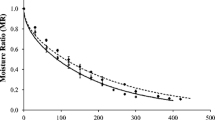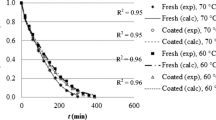Abstract
One of the main drawbacks of drying fruits is the degradation of their quality by oxidative processes. In this study, antioxidant pectin coatings were prepared and applied onto kiwi slices before the drying process to evaluate their effect on drying kinetics, on maintaining nutritional quality and antioxidant capacity of the cut fruit, and during 31 days of storage. Pectin antioxidant coating formulations have been developed by adding antioxidant extracts from fruits or antioxidant acids. Uncoated dehydrated fruits and those coated with pectin without antioxidants were used as control. Convective drying was carried out, desorption isotherms (30, 50 and 60°C) and drying kinetics (50 and 60°C) were analyzed, and the obtained experimental data were adjusted to the GAB and Page models, respectively. The dried kiwi slices were evaluated for their retention of antioxidants (vitamin C and phenolic compounds), total antioxidant activity (DPPH), mechanical properties, and color. The coatings had a slight influence on the isotherms and drying kinetics at the studied temperatures, mainly for the one performed at 30°C. However, the drying rate at 60°C decreased more rapidly and the Page model fit well with the experimental data. The antioxidant coatings preserved the thermosensitive compounds during drying, and formulations with the acerola extract and antioxidant acids may be highlighted since, in addition to the antioxidant effect, they also nutritionally enriched the kiwi slices. Thus, the proposed methodology is a promising technique to reduce the oxidative effects inherent in the drying and storage processes.






Similar content being viewed by others
References
Presti, G, Guarrasi, V, Gulotta, E, Provenzano, F, Provenzano, A, Giuliano, S, Monfreda, M, Mangione, MR, Passantino, R, Biagio, PLS, Costa, MA, Giacomazza, D, “Bioactive Compounds from Extra Virgin Olive Oils: Correlation Between Phenolic Content and Oxidative Stress Cell Protection.” Biophys. Chem., 230 109–116 (2017)
Gonzáles-Vallinas, M, González-Castejón, M, Rodríguez-Casado, A, De Molina, AR, “Dietary Phytochemicals in Cancer Prevention and Therapy: A Complementary Approach with Promising Perspectives.” Nutr. Rev., 71 (9) 585–599 (2013)
Saenglee, S, Jogloy, S, Patanothai, A, Leid, M, Senawong, T, “Cytotoxic Effects of Peanut Phenolics Possessing Histone Deacetylase Inhibitory Activity in Breast and Cervical Cancer Cell Lines.” Pharmacol. Rep., 68 1102–1110 (2016)
Du, H, Li, L, Bennett, D, Guo, Y, Key, TJ, Bian, Z, Sherliker, P, Gao, H, Yiping, C, Yang, L, Chen, J, Wang, S, Du, R, Su, H, Collins, R, Peto, R, Chen, Z, “Fresh Fruit Consumption and Major Cardiovascular Disease in China.” N. Engl. J. Med., 374 (14) 1332–1343 (2016)
Kim, J, Lee, HJ, Lee, KJ, “Naturally Occurring Phytochemical for the Prevention of Alzheimer’s Disease.” J. Neurochem., 112 1415–1430 (2010)
Tresserra-Rimbau, A, Guasch-Ferré, M, Salas-Salvadó, J, Toledo, E, Corella, D, Castaner, O, Guo, X, Gómez-Gracia, E, Lapetra, J, Arós, F, Fiol, M, Ros, E, Serra-Majem, L, Pintó, X, Fitó, M, Babio, N, Martínez-González, MA, Sorli, JV, López-Sabater, MC, Estruch, R, Lamuela-Raventós, RM, “Intake of Total Polyphenols and Some Classes of Polyphenols is Inversely Associated with Diabetes in Elderly People at High Cardiovascular Disease Risk.” J. Nutr., 146 767–777 (2016)
Soquetta, MB, Stefanello, FS, Da Mota Huerta, K, Monteiro, SS, Da Rosa, CS, Terra, NN, “Characterization of Physiochemical and Microbiological Properties, and Bioactive Compounds, of Flour Made from the Skin and Bagasse of Kiwi Fruit (Actinidia deliciosa).” Food Chem., 199 471–478 (2016)
Park, YS, Im, MH, Choi, JH, Yim, SH, Leontowicz, H, Leontowicz, M, Suhaj, M, Gorinstein, S, “The Effects of Ethylene Treatment on the Bioactivity of Conventional and Organic Growing ‘Hayward’ Kiwi Fruit.” Sci. Hortic., 164 589–595 (2013)
Kaya, A, Aydın, O, Dincer, I, “Experimental and Numerical Investigation of Heat and Mass Transfer During Drying of Hayward Kiwi Fruits (Actinidia deliciosa Planch).” J. Food Eng., 88 323–330 (2008)
Darvishi, H, Zarein, M, Farhudi, Z, “Energetic and Exergetic Performance Analysis and Modeling of Drying Kinetics of Kiwi Slices.” J. Food Sci. Technol., 53 2317–2333 (2016)
Laurienzo, P, Stasio, M, Di Malinconico, M, Volpe, MG, “De-Hydration of Apples by Innovative Bio-Films Drying.” J. Food Eng., 97 491–496 (2010)
Lago-Vanzela, ES, Do Nascimento, P, Fontes, EAF, Mauro, MA, Kimura, M, “Edible Coatings from Native and Modified Starches Retain Carotenoids in Pumpkin During Drying.” LWT Food Sci. Technol., 50 420–425 (2013)
Santagata, G, Mallardo, S, Fasulo, G, Lavermicocca, P, Valerio, F, Biase, MD, Stasio, MD, Malinconico, M, Volpe, MG, “Pectin-Honey Coating as Novel Dehydrating Bioactive Agent for Cut Fruit: Enhancement of the Functional Properties of Coated Dried Fruits.” Food Chem., 258 104–110 (2018)
Tesfay, SZ, Magwaza, LS, “Evaluating the Efficacy of Moringa Leaf Extract, Chitosan and Carboxymethyl Cellulose as Edible Coatings for Enhancing Quality and Extending Postharvest Life of Avocado (Persea americana Mill.) Fruit.” Food Packag. Shelf Life, 11 40–48 (2017)
Tesfay, SZ, Magwaza, LS, Mbili, N, Mditshwa, A, “Carboxyl Methylcellulose (CMC) Containing Moringa Plant Extracts as New Postharvest Organic Edible Coating for Avocado (Persea americana Mill.) Fruit.” Sci. Hortic., 226 201–207 (2017)
Saba, MK, Sogvar, OB, “Combination of Carboxymethyl Cellulose-Based Coatings with Calcium and Ascorbic Acid Impacts in Browning and Quality of Fresh-Cut Apples.” LWT Food Sci. Technol., 66 165–171 (2016)
Rojas-Graü, MA, Tapia, MS, Rodríguez, FJ, Carmona, AJ, Martin-Belloso, O, “Alginate and Gellan-Based Edible Coatings as Carriers of Antibrowning Agents Applied on Fresh-Cut Fuji Apples.” Food Hydrocoll., 21 118–127 (2007)
Eça, KS, Machado, MT, Hubinger, MD, Menegalli, FC, “Development of Active Films from Pectin and Fruit Extracts: Light Protection, Antioxidant Capacity, and Compounds Stability.” J. Food Sci., 80 (11) 2389–2896 (2015)
Jowitt, R, Escher, F, Kent, M, McKenna, B, Roques, M, Physical Properties Foods II. Elsevier Applied Science Publishers, London, 1987
Page, C, Factors Influencing the Maximum Rate of Drying Shelled Corn in Layers. M.Sc. Dissertation. Purdue University, Indiana, USA, 1949
Crank, J, The Mathematics of Diffusion. Oxford University Press, Oxford, 1975
Waterhouse, AL, “Determination of Total Phenolics.” In: Current Protocols in Food Analytical Chemistry, vol. 6, chap. 1, pp. I1.1.1–I1.1.8. Wiley (2002)
AOAC, Official Methods of Analysis of A.O.A.C International. William Horwitz, Arlington, 2006
Brand-Williams, W, Cuvelier, ME, Berset, C, “Use of a Free Radical Method to Evaluate Antioxidant Activity.” LWT Food Sci. Technol., 28 25–30 (1995)
Shivhare, US, Arora, S, Ahmed, J, Raghavan, GSV, “Moisture Adsorption Isotherms for Mushroom.” LWT Food Sci. Technol., 37 133–137 (2004)
Lahsasni, S, Kouhila, M, Mahrouz, M, “Adsorption–Desorption Isotherms and Heat of Sorption of Prickly Pear Fruit (Opuntia ficus indica).” Energy Convers. Manag., 45 249–261 (2004)
Moreira, R, Chenlo, F, Torres, MD, Vallejo, N, “Thermodynamic Analysis of Experimental Sorption Isotherms of Loquat and Quince Fruits.” J. Food Eng., 88 514–521 (2008)
Van den Berg, C, “Description of Water Activity of Foods for Engineering Purposes by Means of the GAB Model of Sorption.” In: McKenna, BM (ed.) Engineering and Foods, vol. 1, pp. 311–321. Elsevier Applied Science Publishers, New York, US (1984)
Lewicki, PP, “The Applicability of the GAB Model to Food Water Sorption Isotherms.” Int. J. Food Sci. Technol., 32 533–557 (1997)
Telis, VRN, Gabas, AL, Menegalli, FC, Telis-Romero, J, “Water Sorption Thermodynamic Properties Applied to Persimmon Skin and Pulp.” Thermochim. Acta, 343 49–56 (2000)
Sousa, SD, Obtenção de figos secos por desidratação osmótica e secagem convectiva. University of Campinas, Campinas, BR, 2008
Canizares, D, Mauro, MA, “Enhancement of Quality and Stability of Dried Papaya by Pectin-Based Coatings as Air-Drying Pretreatment.” Food Bioprocess. Technol., 8 1187–1197 (2015)
Bennett, LE, Jegasothy, H, Konczak, I, Frank, D, Sudharmarajan, S, Clingeleffer, PR, “Total Polyphenolics and Antioxidant Properties of Selected Dried Fruits and Relationships to Drying Conditions.” J. Funct. Foods, 3 115–124 (2011)
Maskan, M, “Kinetics of Colour Change of Kiwifruits During Hot Air and Microwave Drying.” J. Food Eng., 48 169–175 (2001)
Meletis, CD, Barker, JE, “Synergy in Nutrients.” J. Altern. Complement. Med., 10 326–329 (2004)
Sakooei-Vayghan, R, Peighambardoust, SH, Hesari, J, Peressini, D, “Effects of Osmotic Dehydration (With and Without Sonication) and Pectin-Based Coating Pretreatments on Functional Properties and Color of Hot-Air Dried Apricot Cubes.” Food Chem., 311 125978 (2020)
Zhao, YP, Chang, KC, “Sulfite and Starch Affect Color and Carotenoids of Dehydrated Carrots (Daucus carota) During Storage.” J. Food Sci., 60 324–326 (1995)
Lin, D, Zhao, Y, “Innovations in the Development and Application of Edible Coatings for Fresh and Minimally Processed Fruits and Vegetables.” Compr. Rev. Food Sci. Food Saf., 6 60–75 (2007)
Dehsheikh, FN, Dinani, ST, “Coating Pretreatment of Banana Slices Using Carboxymethyl Cellulose in an Ultrasonic System Before Convective Drying.” Ultrason. Sonochem., 52 401–413 (2019)
Author information
Authors and Affiliations
Contributions
All authors contributed to the study conception and design. Material preparation, data collection, and analysis were performed by KSE. The first draft of the manuscript was written by ECMP and LdSO, and all authors commented on previous versions of the manuscript. All authors read and approved the final version of the manuscript.
Corresponding author
Ethics declarations
Conflict of interest
The authors declare that they have no conflicts of interest.
Additional information
Publisher's Note
Springer Nature remains neutral with regard to jurisdictional claims in published maps and institutional affiliations.
Supplementary Information
Rights and permissions
About this article
Cite this article
Sitônio Eça, K., Maciel Porto, E.C., de Siqueira Oliveira, L. et al. Applying pectin coatings enriched with antioxidant compounds as pre-treatment for kiwi (Actinidia deliciosa) drying process. J Coat Technol Res 18, 1131–1142 (2021). https://doi.org/10.1007/s11998-021-00469-x
Received:
Revised:
Accepted:
Published:
Issue Date:
DOI: https://doi.org/10.1007/s11998-021-00469-x




